Search Result
Results for "
ligand-binding
" in MedChemExpress (MCE) Product Catalog:
5
Isotope-Labeled Compounds
| Cat. No. |
Product Name |
Target |
Research Areas |
Chemical Structure |
-
- HY-13956S
-
|
U 72107-d4
|
PPAR
Ferroptosis
|
Metabolic Disease
Cancer
|
|
Pioglitazone-d4 is a deuterium labeled Pioglitazone. Pioglitazone (U 72107) is a potent and selective PPARγ agonist with high affinity binding to the PPARγ ligand-binding domain with EC50 of 0.93 and 0.99 μM for human and mouse PPARγ, respectively[1].
|
-
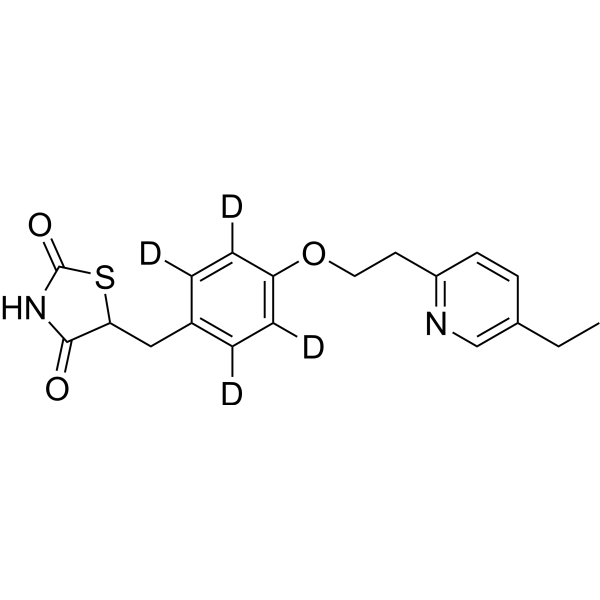
-
- HY-13956
-
Pioglitazone
Maximum Cited Publications
25 Publications Verification
U 72107
|
PPAR
Ferroptosis
|
Metabolic Disease
Cancer
|
|
Pioglitazone (U 72107) is an orally active and selective PPARγ (peroxisome proliferator-activated receptor) agonist with high affinity binding to the PPARγ ligand-binding domain with EC50 of 0.93 and 0.99 μM for human and mouse PPARγ, respectively. Pioglitazone can be used in diabetes research .
|
-
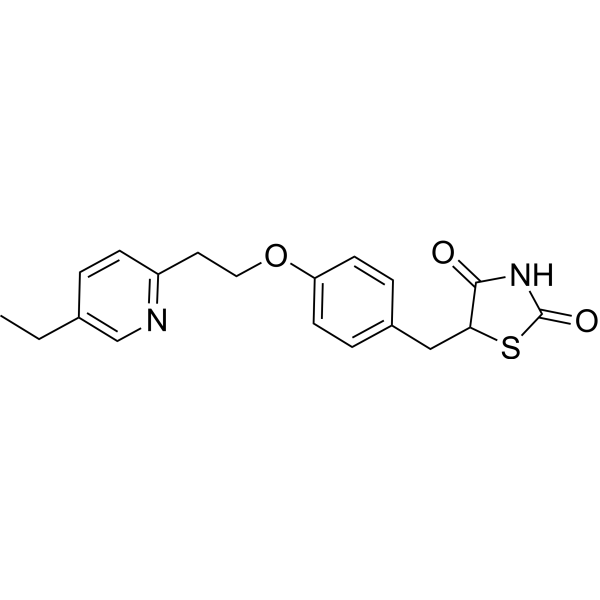
-
- HY-N4194
-
|
|
PPAR
|
Metabolic Disease
|
|
Glabrone is an isoflavone isolated from Glycyrrhiza glabra roots. Glabrone exhibits anti-influenza activity and significant PPAR-γ ligand-binding activity .
|
-
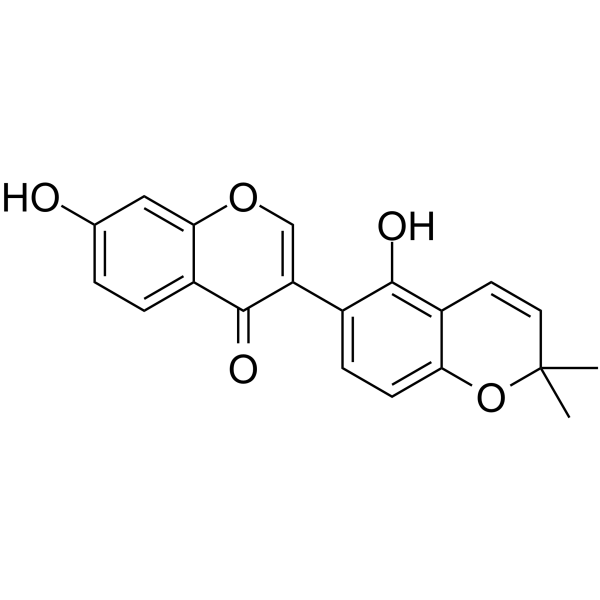
-
- HY-136242
-
|
|
Androgen Receptor
|
Endocrinology
Cancer
|
|
UT-34 is a potent, selective and orally active second-generation pan-androgen receptor (AR) antagonist and degrader with IC50s of 211.7 nM, 262.4 nM and 215.7 nM for wild-type, F876L and W741L AR, respectively. UT-34 binds to ligand-binding domain (LBD) and function-1 (AF-1) domains and requires ubiquitin proteasome pathway to degrade the AR. UT-34 has anti-prostate cancer efficacy .
|
-
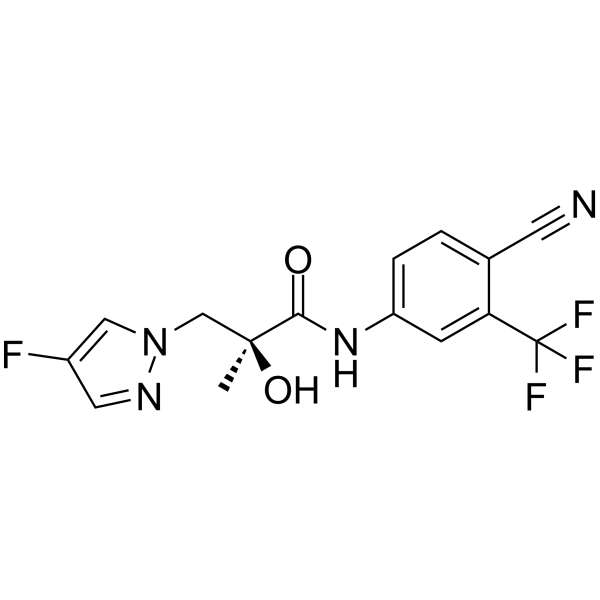
-
- HY-13956B
-
|
U 72107 potassium
|
PPAR
Ferroptosis
|
Metabolic Disease
Cancer
|
|
Pioglitazone (U 72107) potassium is an orally active and selective PPARγ (peroxisome proliferator-activated receptor) agonist with high affinity binding to the PPARγ ligand-binding domain with EC50 of 0.93 μM and 0.99 μM for human and mouse PPARγ, respectively. Pioglitazone potassium can be used in diabetes research .
|
-

-
- HY-N11773
-
|
|
PPAR
|
Metabolic Disease
|
|
Gancaonin L is an isoflavone, that can be isolated from Glycyrrhiza glabra roots. Gancaonin L exhibits significant PPAR-γ ligand-binding activity. Gancaonin L can be used for anti-diabetes and anti-obesity research .
|
-
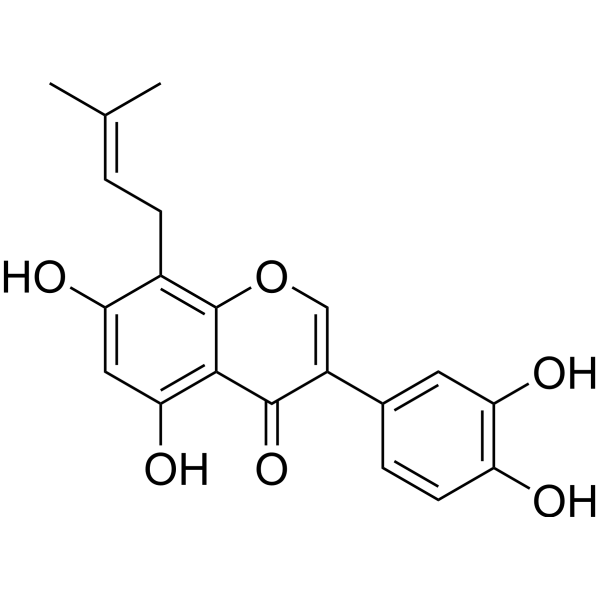
-
- HY-108822
-
|
Arcalyst; IL 1 Trap; Interleukin 1 Trap
|
Interleukin Related
|
Inflammation/Immunology
|
|
Rilonacept (Arcalyst), a dimeric fusion protein, is a interleukin 1 inhibitor. Rilonacept consists of the ligand-binding domains of the extracellular portions of the IL-1R components linked to the Fc portion of human IgG1. Rilonacept can be used for the research of cryopyrin-associated periodic syndromes .
|
-
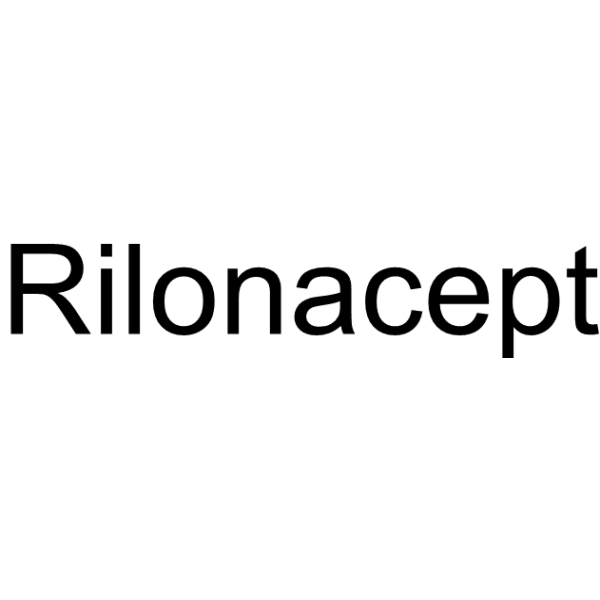
-
- HY-13956S1
-
|
|
Isotope-Labeled Compounds
PPAR
Ferroptosis
|
Metabolic Disease
Cancer
|
|
Pioglitazone-d4 (alkyl) (U 72107-d4 (alkyl)) is the deuterium labeled Pioglitazone. Pioglitazone (U 72107) is a potent and selective PPARγ agonist with high affinity binding to the PPARγ ligand-binding domain with EC50 of 0.93 and 0.99 μM for human and mouse PPARγ, respectively[1][2].
|
-
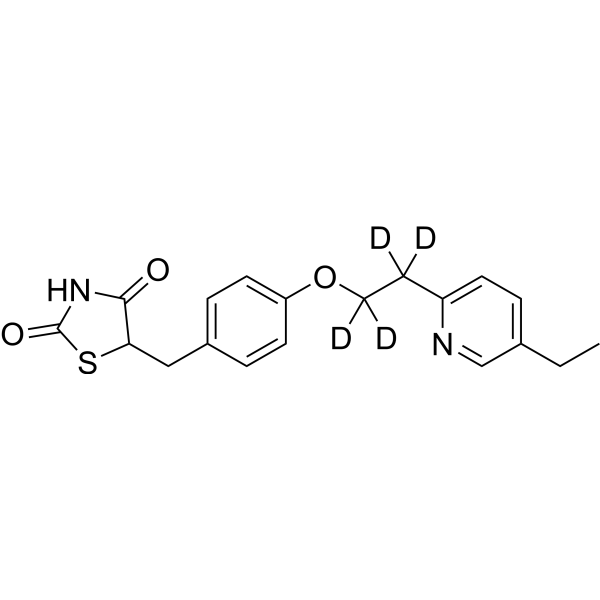
-
- HY-111254
-
|
|
PPAR
|
Metabolic Disease
|
|
GQ-16 is a moderate affinity ligand for the ligand-binding domain (LBD) of PPARγ, exhibiting a Ki of 160 nM. GQ-16 is an effective inhibitor of Cdk5-mediated phosphorylation of PPARγ. GQ-16 is a partial agonist of PPARγ with reduced adipogenic actions. GQ-16 promotes insulin Sensitization without weight gain .
|
-
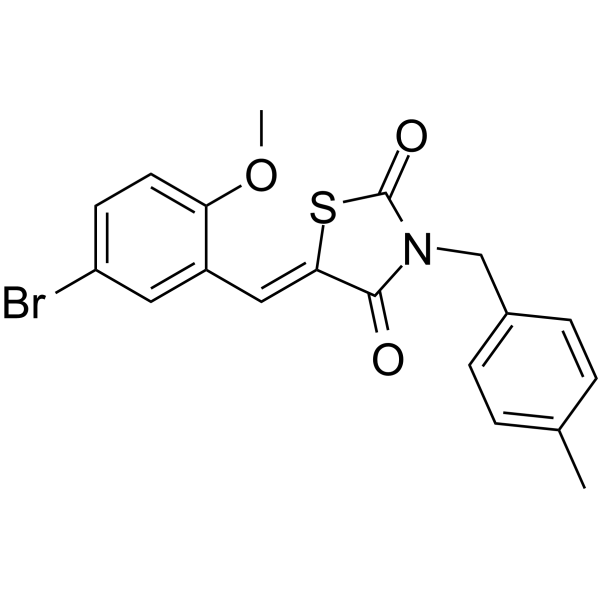
-
- HY-P2264
-
|
|
Ephrin Receptor
|
Inflammation/Immunology
|
|
KYL peptide, an antagonistic peptide, selectively targets EphA4 receptor (IC50:4.22 μM, Kd:1.3 μM). KYL peptide binds to the ligand-binding domain of EphA4, effectively alleviates Aβ-induced synaptic dysfunction and synaptic plasticity defects in AD mice. KYL peptide can promote nerve regeneration after injury and modulating immune responses .
|
-
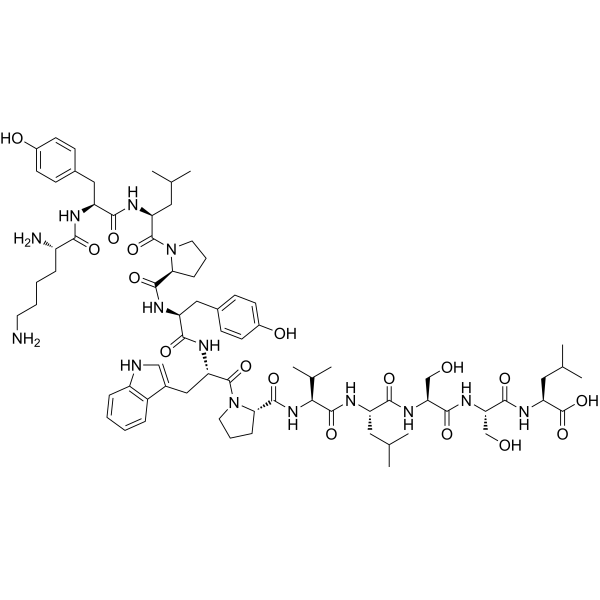
-
- HY-132205
-
|
|
Estrogen Receptor/ERR
|
Metabolic Disease
|
|
DS45500853 is an estrogen-related receptor α (ERRα) agonist. DS45500853 inhibits the binding between receptor-interacting protein 140 (RIP140) corepressor peptide (10 nM) and GST-ERRα ligand-binding domain (LBD; 1.2 μM) with an IC50 value of 0.80 μM. DS45500853 can be used for the research of metabolic disorders, including type 2 diabetes mellitus (T2DM) .
|
-
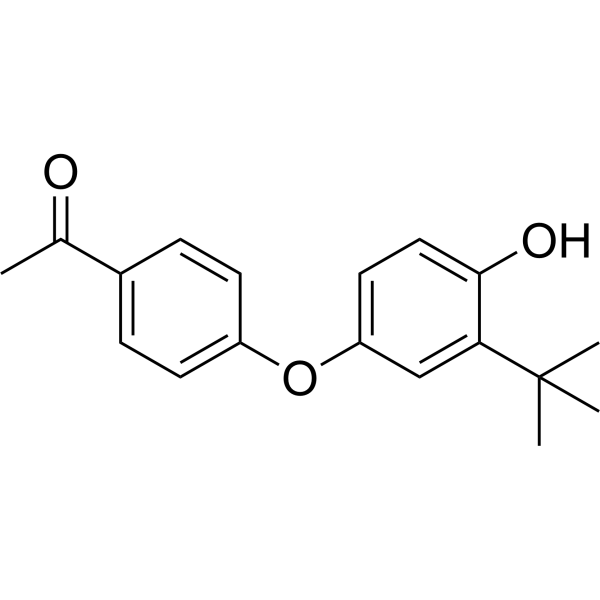
-
- HY-143201
-
|
|
Estrogen Receptor/ERR
|
Metabolic Disease
|
|
DS20362725 is an estrogen-related receptor α (ERRα) agonist. DS20362725 inhibits the binding between receptor-interacting protein 140 (RIP140) corepressor peptide (10 nM) and GST-ERRα ligand-binding domain (LBD; 1.2 μM) with an IC50 value of 0.6 μM. DS20362725 can be used for the research of metabolic disorders, including type 2 diabetes mellitus (T2DM) .
|
-

-
- HY-122742
-
|
|
iGluR
|
Neurological Disease
|
|
HBT1 is a potent α-Amino-3-hydroxy-5-methyl-4-isoxazole-propionic acid (AMPA) receptor (AMPA-R) potentiator. HBT1 bonds with S518 in the ligand-binding domain (LBD) of AMPA-R in a glutamate-dependent manner. HBT1 did not show remarkable bell-shaped response in brain-derived neurotrophic factor (BDNF) production in primary neurons .
|
-

-
- HY-N2025
-
|
|
PPAR
Glucosidase
|
Metabolic Disease
|
|
Oroxin A is the major component of an ethanol-water Oroxylum indicum (L.) Kurz (Bignoniaceae) seed extract (OISE). Oroxin A acts as a partial PPARγ agonist that can activate PPARγ transcriptional activation. Oroxin A activates PPARγ by docking into the PPARγ protein ligand-binding domain. Oroxin A also exhibits an inhibitory activity against α-glucosidase and an antioxidant capacity . Oroxin A exerts anti-breast cancer effects by inducing ER stress-mediated senescence .
|
-
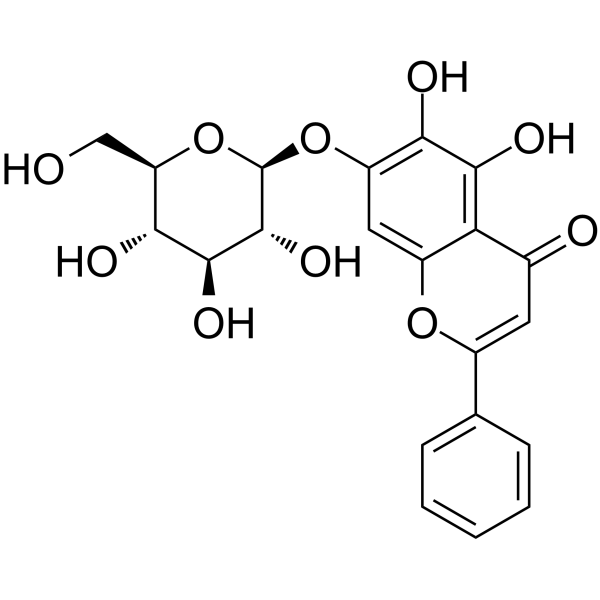
-
- HY-117727
-
|
MIN-102; Hydroxypioglitazone
|
PPAR
|
Metabolic Disease
|
|
Leriglitazone (MIN-102; Hydroxypioglitazone), a metabolite of pioglitazone. Leriglitazone PioOH is a PPARγ agonist, stabilizes the PPARγ activation function-2 (AF-2) co-activator binding surface and enhances co-activator binding, affording slightly better transcriptional efficacy. Leriglitazone binds to the PPARγ C-terminal ligand-binding domain (LBD) with a Ki of 1.2 μM,Leriglitazone induces transcriptional efficacy of the PPARγ (LBD) with an EC50 of 680 nM .
|
-
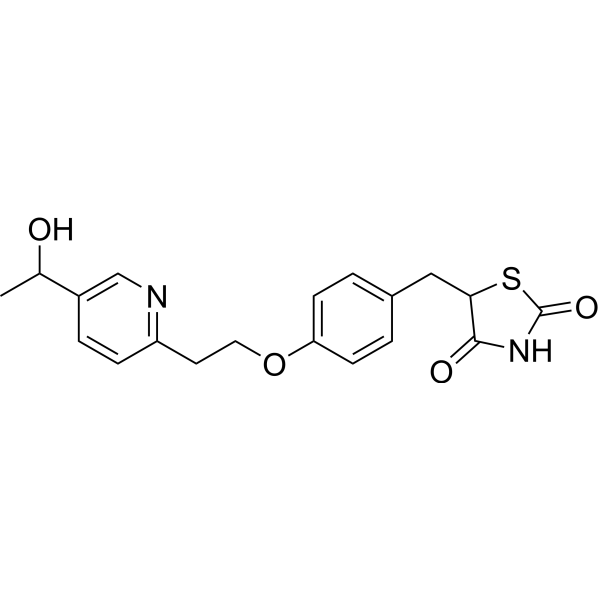
-
- HY-117727A
-
|
MIN-102 hydrochloride; Hydroxypioglitazone hydrochloride
|
PPAR
|
Metabolic Disease
|
|
Leriglitazone (MIN-102; Hydroxypioglitazone) hydrochloride, a metabolite of pioglitazone. Leriglitazone hydrochloride PioOH is a PPARγ agonist, stabilizes the PPARγ activation function-2 (AF-2) co-activator binding surface and enhances co-activator binding, affording slightly better transcriptional efficacy. Leriglitazone hydrochloride binds to the PPARγ C-terminal ligand-binding domain (LBD) with a Ki of 1.2 μM,Leriglitazone induces transcriptional efficacy of the PPARγ (LBD) with an EC50 of 680 nM .
|
-
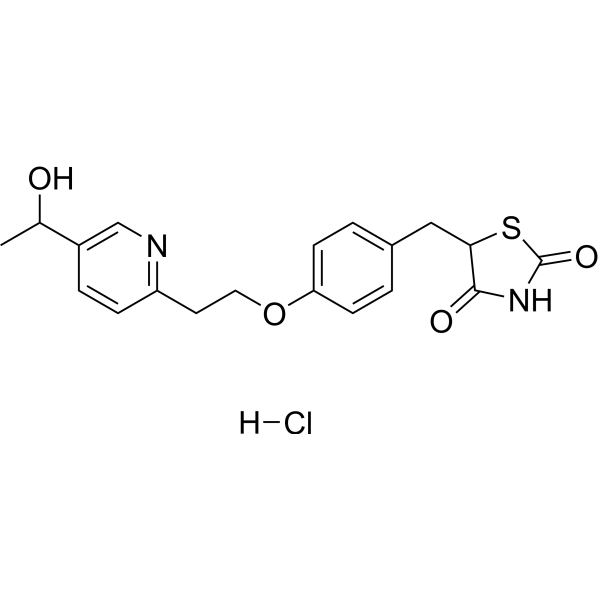
-
- HY-156190
-
|
|
Others
|
Cancer
|
|
NR2F6 modulator-2 (CIA1) is a potent and selective orphan nuclear receptor COUP-TFII (NR2F2) inhibitor. NR2F6 modulator-2 substantially inhibits COUP-TFII–driven NGFIA reporter expression. NR2F6 modulator-2 directly binds to the COUP-TFII ligand-binding domain and disrupts COUP-TFII interaction with transcription regulators, including FOXA1, thus repressing COUP-TFII activity on target gene regulation .
|
-
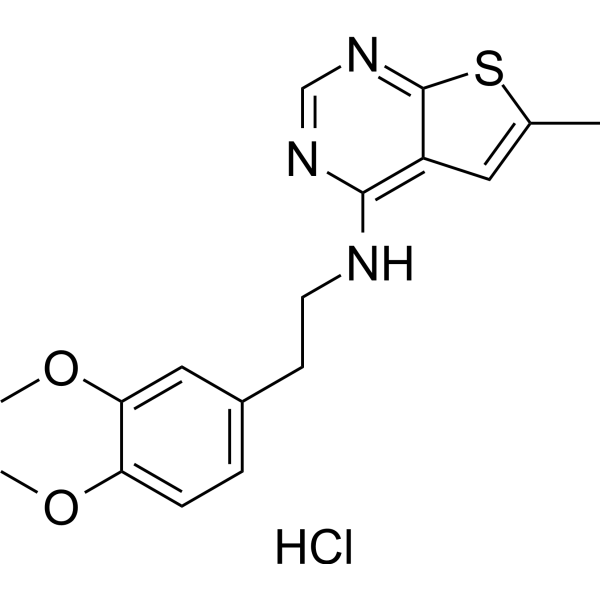
-
- HY-160250
-
|
|
UGT
|
Metabolic Disease
|
|
UGT1A1-IN-1 (compound 2) is a non-competitive inhibitor of UGT1A1, which can inhibit the 1-O-glucuronidation process mediated by UGT1A1 with a Ki value of 5.02 μM. UGT1A1-IN-1 (compound 2) can bind on UGT1A1 at the same ligand-binding site as bilirubin (HY-N0323). UGT1A1-IN-1 can serve as a ‘turn-on’ fluorescent probe substrate for UGT1A1 .
|
-
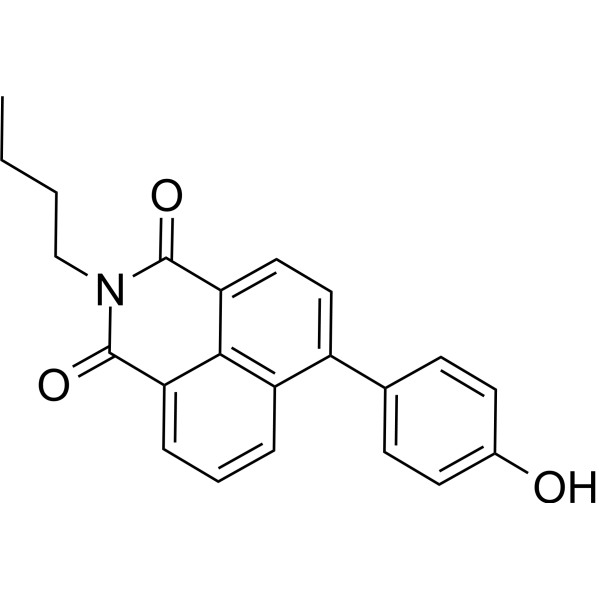
-
- HY-117727S
-
|
MIN-102-d4; Hydroxypioglitazone-d4
|
Isotope-Labeled Compounds
PPAR
|
Metabolic Disease
|
|
Leriglitazone-d4 (MIN-102-d4; Hydroxypioglitazone-d4) is deuterium labeled Leriglitazone. Leriglitazone (Hydroxypioglitazone), a metabolite of pioglitazone.Leriglitazone (Hydroxypioglitazone) PioOH is a PPARγ agonist, stabilizes the PPARγ activation function-2 (AF-2) co-activator binding surface and enhances co-activator binding, affording slightly better transcriptional efficacy.Leriglitazone (Hydroxypioglitazone) binds to the PPARγ C-terminal ligand-binding domain (LBD) with Ki of 1.2 μM,induces transcriptional efficacy of the PPARγ (LBD) with EC50 of 680 nM .
|
-

-
- HY-156190A
-
|
|
Others
|
Cancer
|
|
NR2F2-IN-1 (free base) is a potent and selective orphan nuclear receptor COUP-TFII (NR2F2) inhibitor. NR2F2-IN-1 (free base) substantially inhibits COUP-TFII–driven NGFIA reporter expression. NR2F2-IN-1 (free base) directly binds to the COUP-TFII ligand-binding domain and disrupts COUP-TFII interaction with transcription regulators, including FOXA1, thus repressing COUP-TFII activity on target gene regulation .
|
-
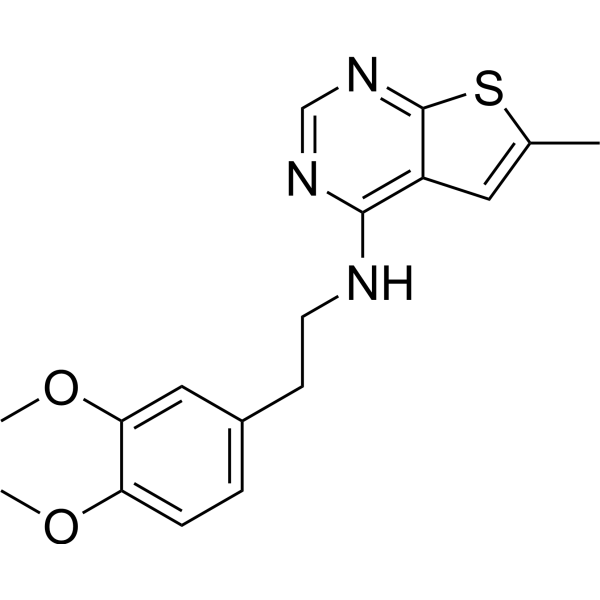
-
- HY-111844
-
|
|
SNIPERs
PROTACs
RAR/RXR
|
Cancer
|
|
PROTAC RAR Degrader-1 comprises a IAP ligand binding group, a linker and a RAR ligand binding group. PROTAC RAR Degrader-1 is an RAR degrader. Maximal RAR degradation at 30 μM concentration in HT1080 cells. Degradation inducers based on cIAP1 are called specific and non-genetic IAP-dependent protein erasers (SNIPERs) .
|
-
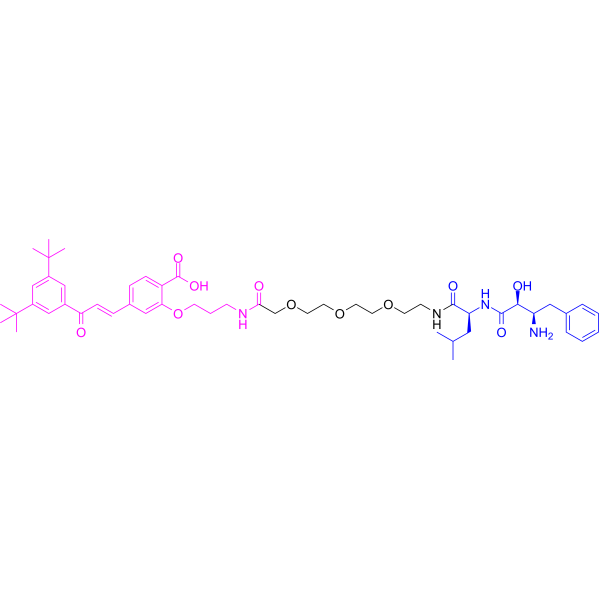
-
- HY-101601
-
-
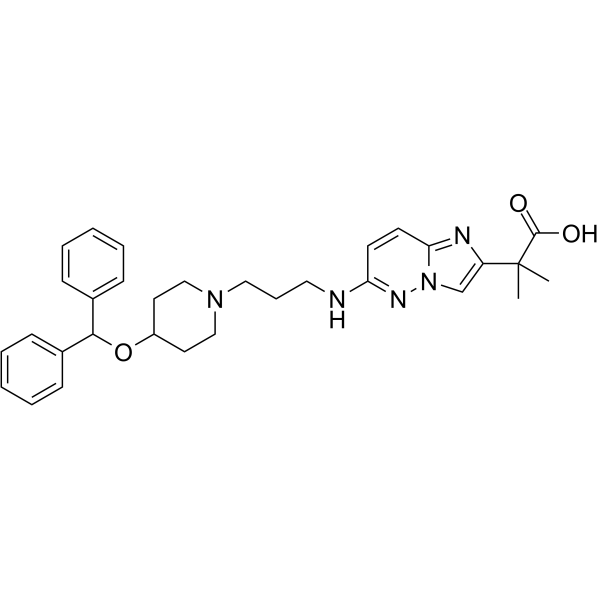
-
- HY-119782
-
|
|
Fluorescent Dye
|
Others
|
|
L-Argininamide is a hydrophilic amino acid derivative and can be used as a compound for ligand binding DNA aptamers. L-Argininamide has the potential for fluorescent aptasensors development .
|
-
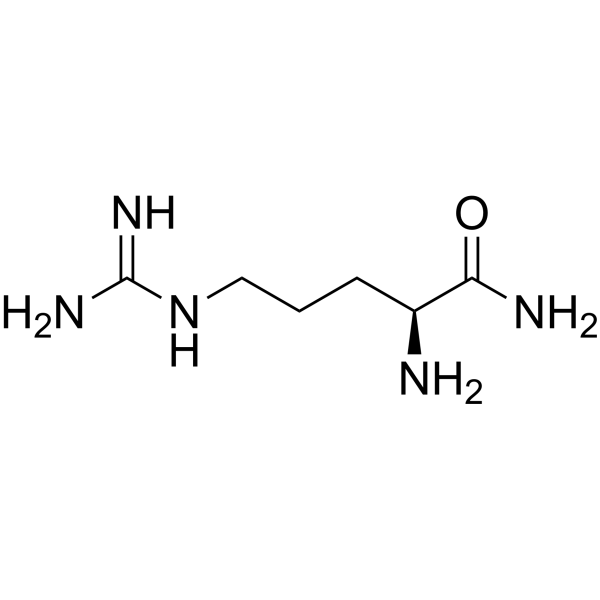
-
- HY-D1398
-
|
|
nAChR
|
Neurological Disease
|
|
LtIA-F, a novel fluorescent analogue of LtIA, provides a wealth of pharmacological tools to explore the structure–function relationship, distribution, and ligand binding domain of the α3β2 nAChR subtype.
|
-
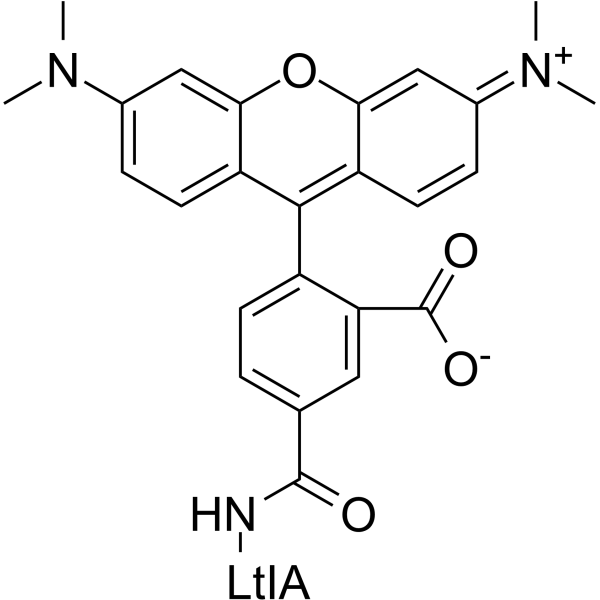
-
- HY-135345
-
|
|
PROTACs
FKBP
|
Cancer
|
|
PROTAC FKBP Degrader-3 is a PROTAC that comprises a FKBP ligand binding group, a linker and an von Hippel-Lindau binding group. PROTAC FKBP Degrader-3 is a potent FKBP degrader .
|
-

-
- HY-130714
-
|
|
PROTACs
|
Cancer
|
|
TD-165 is a PROTAC-based cereblon (CRBN) degrader. TD-165 comprises a cereblon (CRBN) ligand binding group, a linker and an von Hippel-Landau (VHL) binding group .
|
-

-
- HY-128845
-
|
|
PROTACs
|
Cancer
|
|
PROTAC CRBN Degrader-1 comprises a cereblon (CRBN) ligand binding group, a linker and an von Hippel-Landau (VHL) binding group. PROTAC CRBN Degrader-1 is an cereblon (CRBN) degrader .
|
-
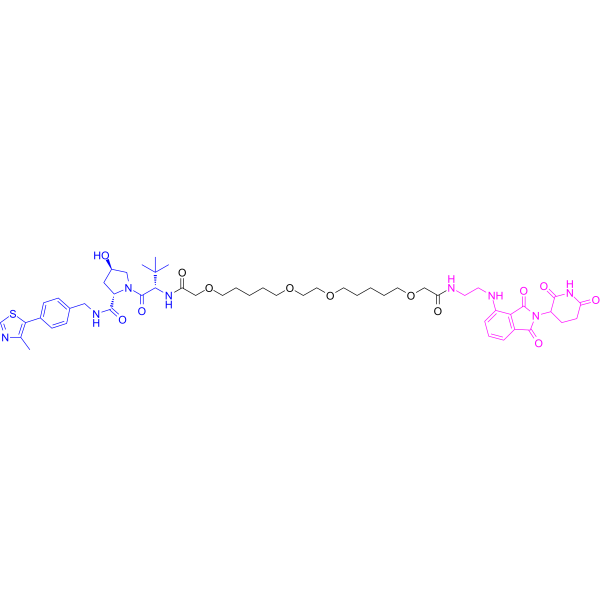
-
- HY-120210
-
|
|
ROR
|
Inflammation/Immunology
Cancer
|
|
XY018 is a potent ROR-γ-selective antagonist. XY018 inhibits ROR-γ constitutive activity in 293T cells with high potency (EC50, 190 nM). XY018 binds to the ROR-γ hydrophobic ligand binding domain (LBD) .
|
-
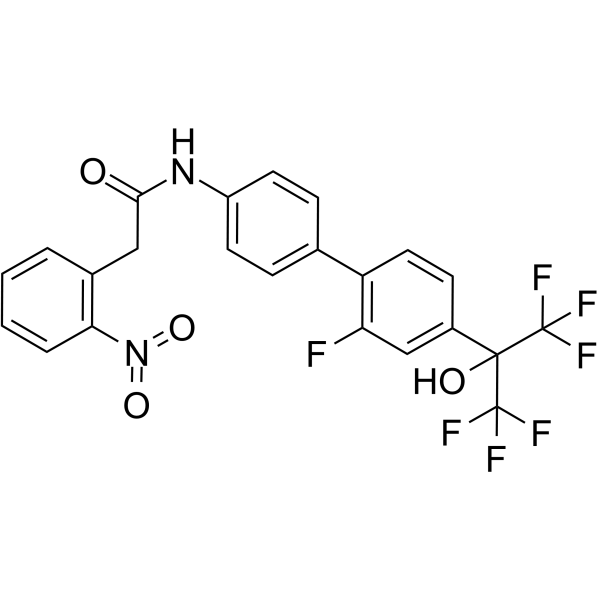
-
- HY-23999
-
|
|
LOX-1
|
Cardiovascular Disease
|
|
BI-0115 is a selective inhibitor of LOX-1 (IC50=5.4 µM) that blocks cellular uptake of oxLDL. BI-0115 binding triggers receptor inhibition by formation of dimers of the homodimeric ligand binding domain .
|
-

-
- HY-128839
-
|
|
PROTACs
Estrogen Receptor/ERR
|
Cancer
|
|
PROTAC ERRα Degrader-2 comprises a MDM2 ligand binding group, a linker and an estrogen-related receptor alpha (ERRa) binding group. PROTAC ERRα Degrader-2 is an estrogen-related receptor alpha (ERRa) degrader .
|
-
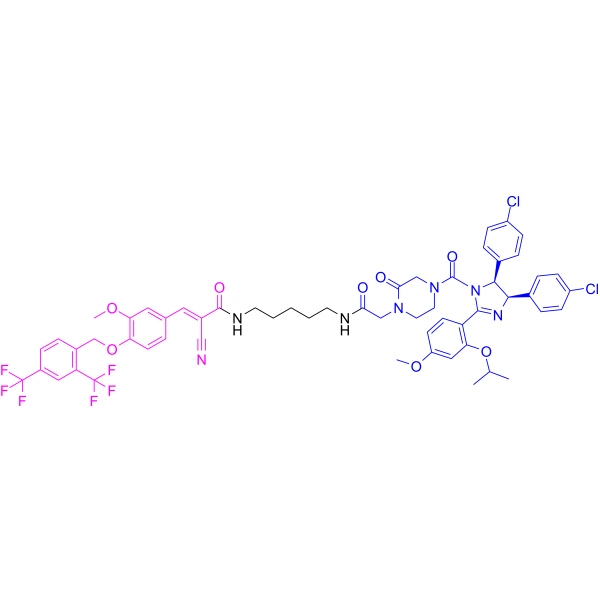
-
- HY-128838
-
|
|
PROTACs
Estrogen Receptor/ERR
|
Cancer
|
|
PROTAC ERRα Degrader-1 comprises a MDM2 ligand binding group, a linker and an estrogen-related receptor alpha (ERRa) binding group. PROTAC ERRα Degrader-1 is an PROTAC estrogen-related receptor alpha (ERRa) degrader .
|
-
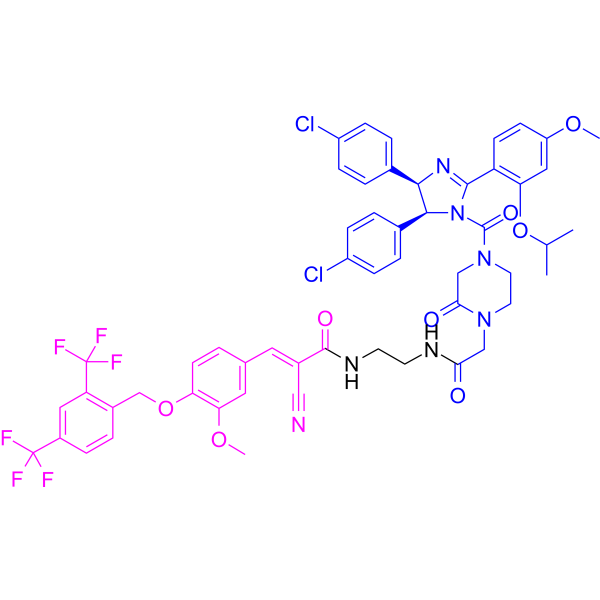
-
- HY-109176
-
|
GDC-9545; RG6171
|
Estrogen Receptor/ERR
|
Cancer
|
|
Giredestrant (GDC-9545), a non-steroidal estrogen receptor (ER) ligand, is an orally active and selective ER antagonist. Giredestrant potently competes with Estradiol for binding and induces a conformational change within the ER ligand binding domain. Giredestrant has anti-tumor activity .
|
-
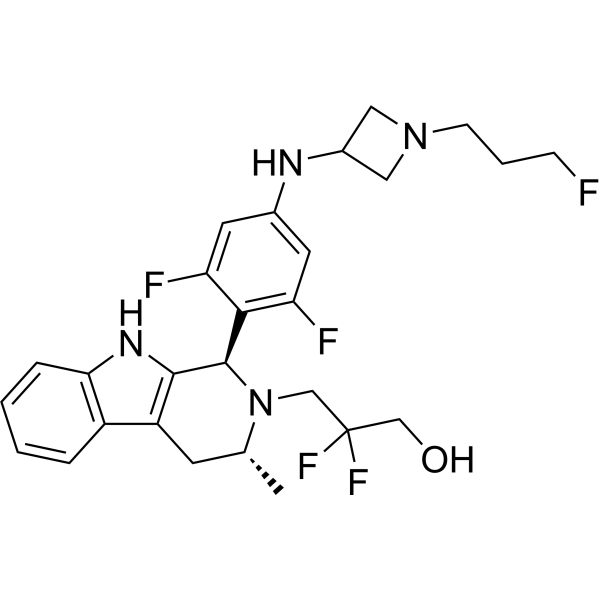
-
- HY-110392
-
|
|
Estrogen Receptor/ERR
|
Cancer
|
|
CMP8, a selective ligand for estrogen receptor, binds to the mutant estrogen receptor ligand binding domain (ERLBD). CMP8 exhibits IC50 values of 29 nM , 41 nM, 1100 nM and 2200 nM for MGERα, MGRERα, hERα and hERβ, respectively .
|
-
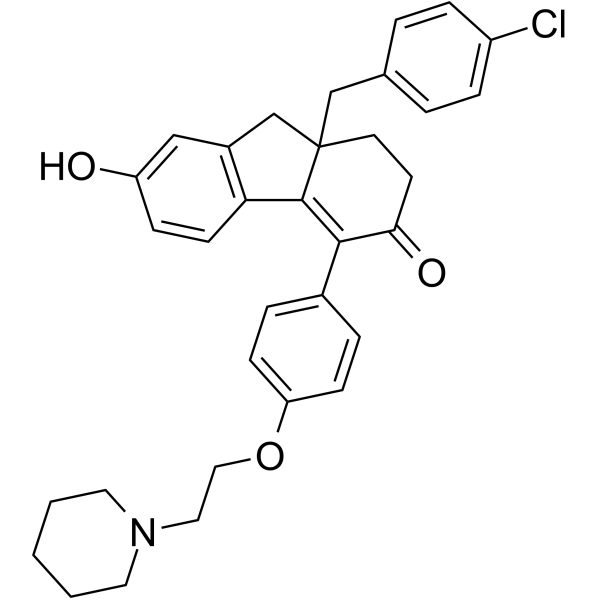
-
- HY-P9977
-
|
JNJ-61186372
|
EGFR
|
Cancer
|
|
Amivantamab (JNJ-61186372) is a human EGFR-MET bispecific antibody with immune anticancer activity. Amivantamab inhibits ligand binding, promotes endocytosis and degradation of receptor-antibody complexes, and induces Fc-dependent cytokinesis in macrophages and antibody-dependent cytotoxicity in natural killer cells .
|
-

-
- HY-135903
-
|
GDC-9545 tartrate; RG6171 tartrate
|
Estrogen Receptor/ERR
|
Cancer
|
|
Giredestrant tartrate (GDC-9545 tartrate), a non-steroidal ER ligand, is an orally active and selective estrogen receptor (ER) antagonist. Giredestrant tartrate potently competes with estradiol for binding and induces a conformational change within the ER ligand binding domain. Anti-tumor activity .
|
-
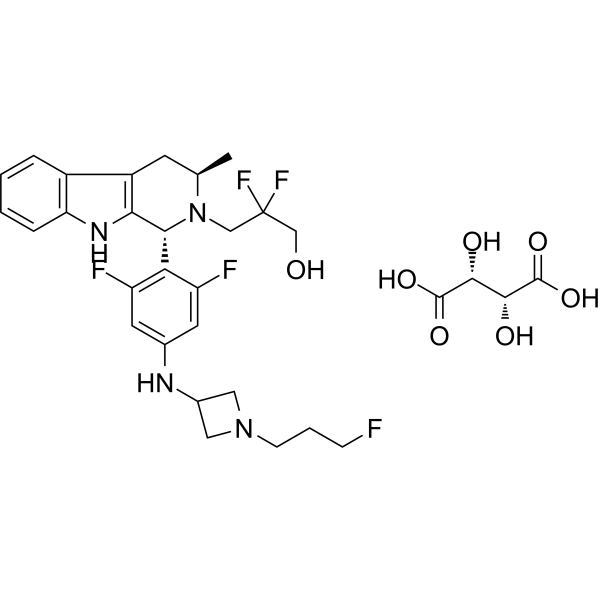
-
- HY-111848A
-
|
|
SNIPERs
PROTACs
Androgen Receptor
|
Cancer
|
|
PROTAC AR Degrader-4 comprises a IAP ligand binding group, a linker and an Androgen Receptor (AR) binding group. PROTAC AR Degrader-4 is an AR degrader. Degradation inducers based on cIAP1 are called specific and non-genetic IAP-dependent protein erasers (SNIPERs) .
|
-
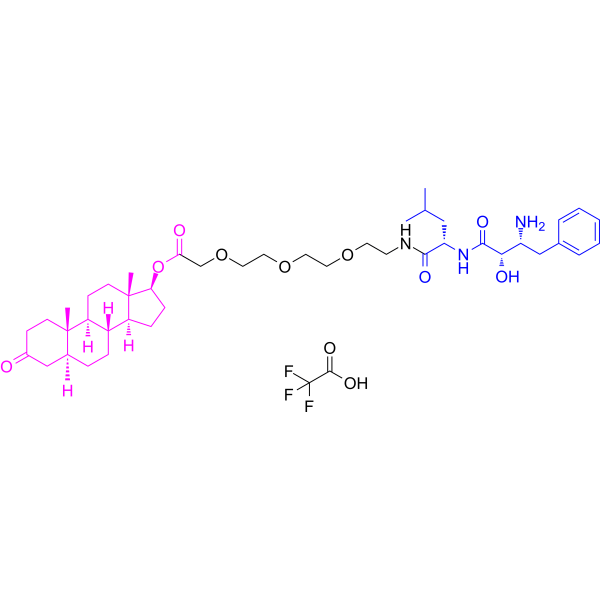
-
- HY-111848
-
|
|
SNIPERs
PROTACs
Androgen Receptor
|
Cancer
|
|
PROTAC AR Degrader-4 comprises a IAP ligand binding group, a linker and an Androgen Receptor (AR) binding group. PROTAC AR Degrader-4 is an AR degrader. Degradation inducers based on cIAP1 are called specific and non-genetic IAP-dependent protein erasers (SNIPERs) .
|
-

-
- HY-B1322A
-
-
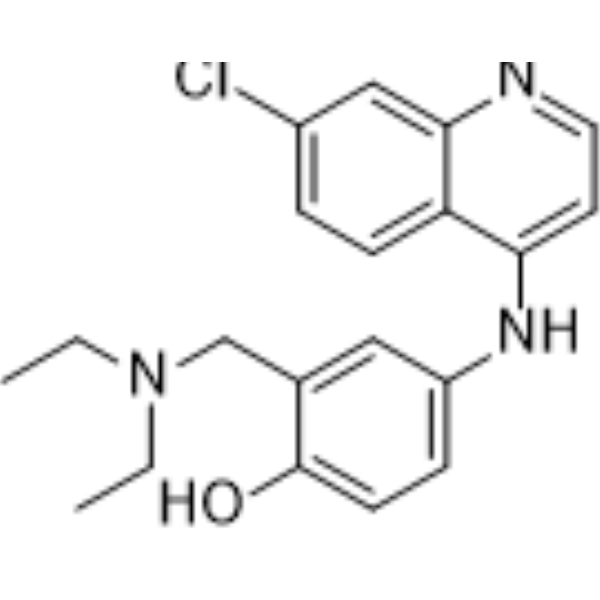
-
- HY-14422
-
|
|
ROR
|
Cancer
|
|
SR1078 is a selective agonist of retinoic acid receptor-related orphan receptor α/γ (RORα/RORγ). SR1078 directly binds to the ligand binding domain of RORα and RORγ and increases the transcriptional activity of these receptors, leading to stimulation of RORα/γ target gene transcription .
|
-
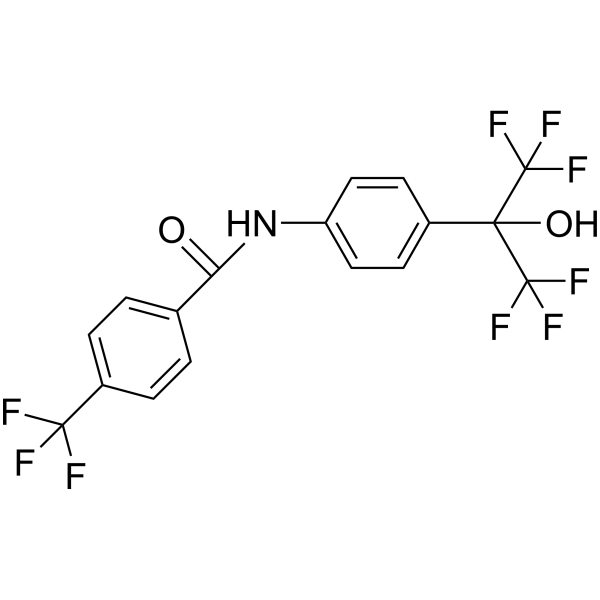
-
- HY-B1322
-
-

-
- HY-B1322B
-
|
Amodiaquin dihydrochloride
|
|
|
|
Amodiaquine dihydrochloride (Amodiaquin dihydrochloride), a 4-aminoquinoline class of antimalarial agent, is a potent and orally active histamine N-methyltransferase inhibitor with a Ki of 18.6 nM. Amodiaquine dihydrochloride is also a Nurr1 agonist and specifically binds to Nurr1-LBD (ligand binding domain) with an EC50 of ~20 μM. Anti-inflammatory effect .
|
-
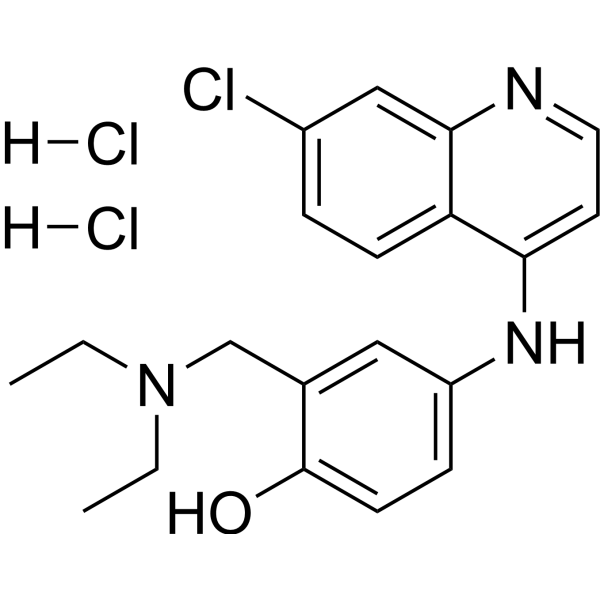
-
- HY-156906
-
|
|
Others
|
Cancer
|
|
UNC3474 is a small molecule ligand, binding with 53BP1. UNC3474 binds the aromatic methyl-lysine binding cage of 53BP1 TT, with a dissociation constant (Kd) of 1.0 ± 0.3 μM. UNC3474 inhibits the recruitment of 53BP1 to DSBs by stabilizing a pre-existing autoinhibited state of 53BP1 in cells .
|
-
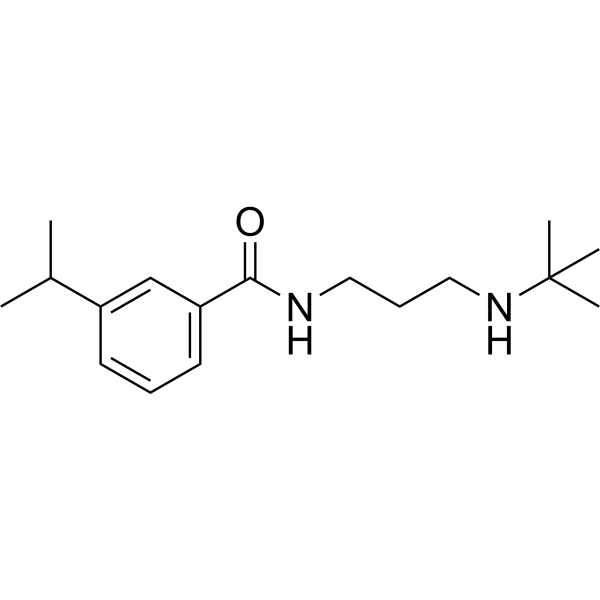
-
- HY-B1322AS
-
|
|
Parasite
Histone Methyltransferase
|
Infection
Neurological Disease
Inflammation/Immunology
|
|
Amodiaquine-d10 is the deuterium labeled Amodiaquine. Amodiaquine (Amodiaquin), a 4-aminoquinoline class of antimalarial agent, is a potent and orally active histamine N-methyltransferase inhibitor. Amodiaquine is also a Nurr1 agonist and specifically binds to Nurr1-LBD (ligand binding domain) with an EC50 of ~20 μM. Anti-inflammatory effect[1][2][3][4].
|
-
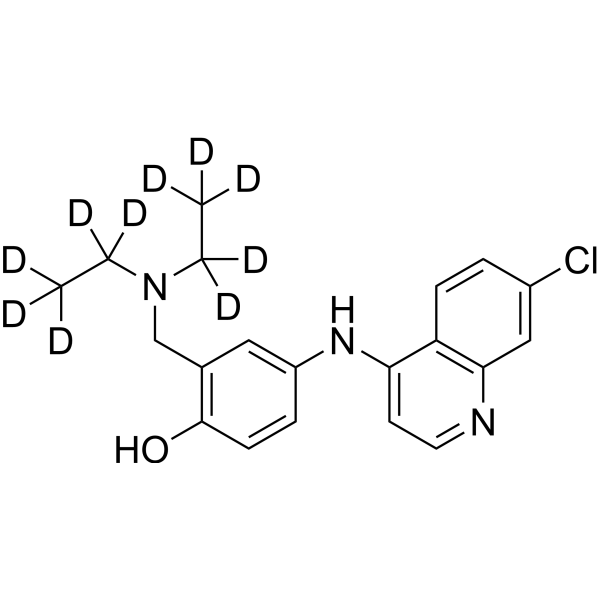
-
- HY-128838A
-
|
|
Estrogen Receptor/ERR
|
Others
|
|
(rel)-PROTAC ERRα Degrader-1 is a relative configuration of PROTAC ERRα Degrader-1. PROTAC ERRα Degrader-1 comprises a MDM2 ligand binding group, a linker and an estrogen-related receptor alpha (ERRa) binding group. PROTAC ERRα Degrader-1 is an estrogen-related receptor alpha (ERRa) degrader .
|
-
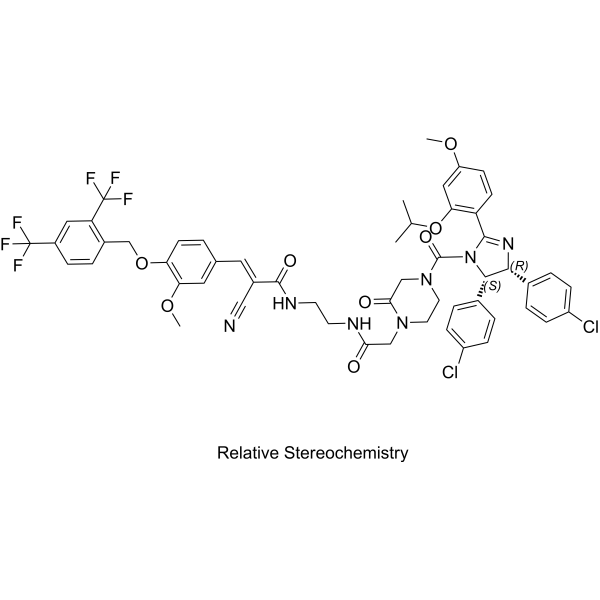
-
- HY-131188
-
|
|
PROTACs
Bcl-2 Family
|
Cancer
|
|
PROTAC Bcl-xL degrader-1 is a PROTAC that comprises a Bcl-xL (Bcl-2 family member) ligand binding group, a linker and an IAP E3 ligases binding group. PROTAC Bcl-xL degrader-1 is a potent Bcl-xL degrader, and shows toxicity for human platelets and MyLa 1929 cells with IC50 values of 62 nM and 8.5 μM, respectively .
|
-
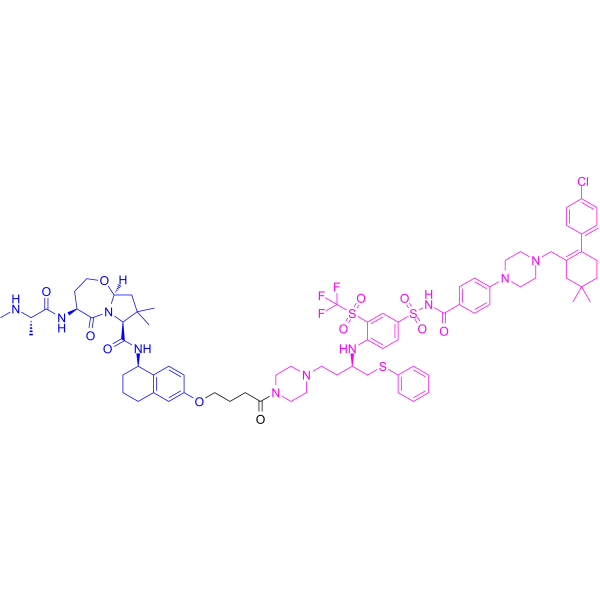
-
- HY-B1322AS1
-
-
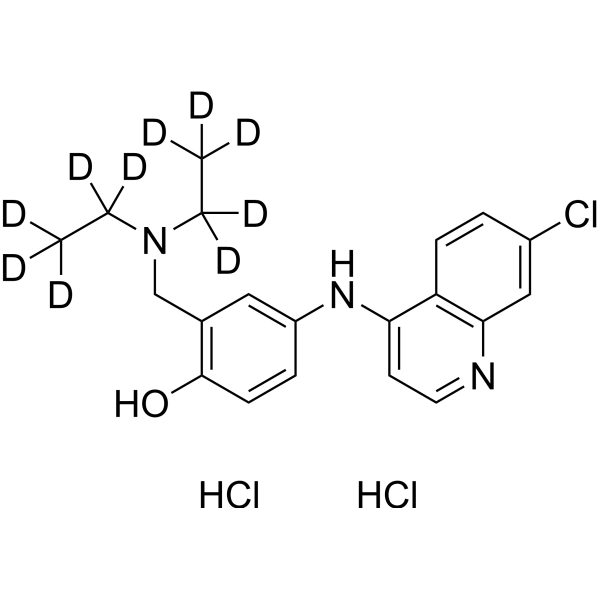
-
- HY-144705
-
|
|
Cannabinoid Receptor
|
Neurological Disease
|
|
GAT564 (Compound 15d) is a potent allosteric modulator of cannabinoid 1 receptor (CB1R) with EC50s of 87 and 320 nM respectively for cAMP and β-arrestin2. GAT564 markedly promotes orthosteric ligand binding to hCB1R. GAT564 is efficacious as a topical agent that significantly reduces intraocular pressure (IOP) in the ocular normotensive murine model of glaucoma .
|
-
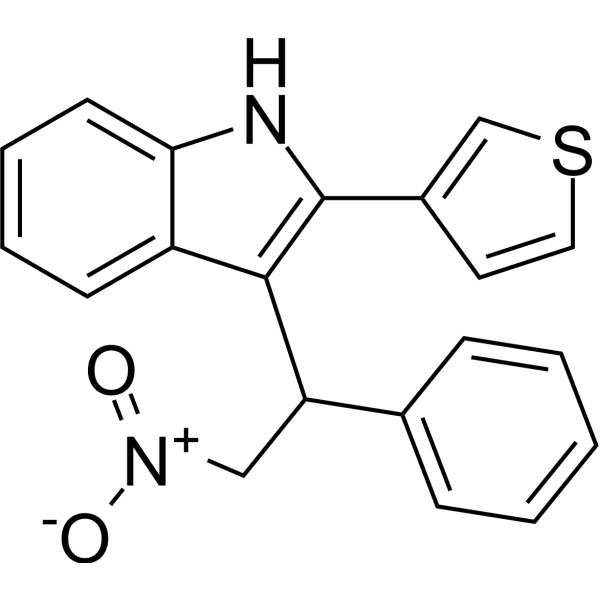
-
- HY-W677684
-
|
|
Nuclear Hormone Receptor 4A/NR4A
|
Others
|
|
Nurr1 agonist 2 (Compound 7) is a Nurr1 agonist (EC50: 0.07 μM). Nurr1 agonist 2 binds to the recombinant Nurr1 ligand binding domain (LBD) with a Kd value of 0.14 μM. Nurr1 agonist 2 increases the Nurr1-regulated genes tyrosine hydroxylase (TH) and vesicular amino acid transporter 2 (VMAT2) mRNA expression .
|
-

-
- HY-111846
-
|
|
SNIPERs
PROTACs
Estrogen Receptor/ERR
|
Cancer
|
|
PROTAC ERα Degrader-2 comprises a IAP ligand binding group, a linker and an estrogen receptor α (ERα) binding group. PROTAC ERα Degrader-2 is an ERα degrader. Maximal ERα degradation at 30 μM concentration in human mammary tumor MCF7 cells. Degradation inducers based on cIAP1 are called specific and non-genetic IAP-dependent protein erasers (SNIPERs) .
|
-
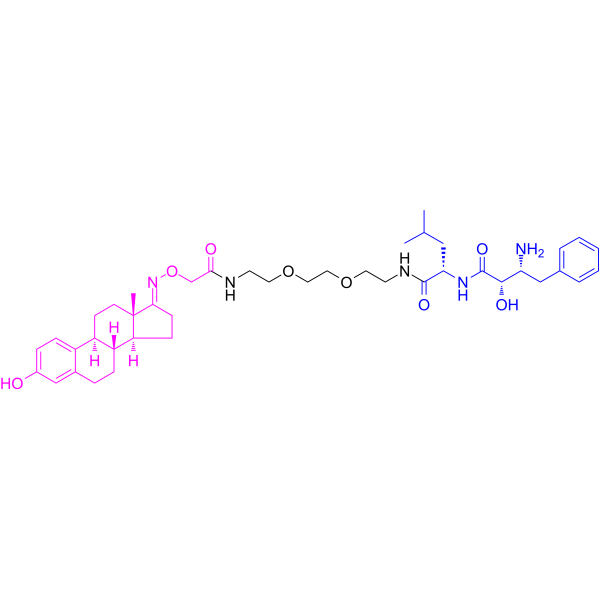
-
- HY-P99165
-
|
|
IGF-1R
TSH Receptor
|
Endocrinology
|
|
Teprotumumab is an IGF-1 receptor (IGF-1R) blocking human monoclonal antibody. Teprotumumab binds to the ligand binding extracellular α-subunit domain of IGF-1R. Teprotumumab inhibits TSH and IGF-1 action in fibrocytes. Teprotumumab attenuates TSH-dependent IL-6 and IL-8 expression and Akt phosphorylation. Teprotumumab can be used for thyroid-associated ophthalmopathy research .
|
-
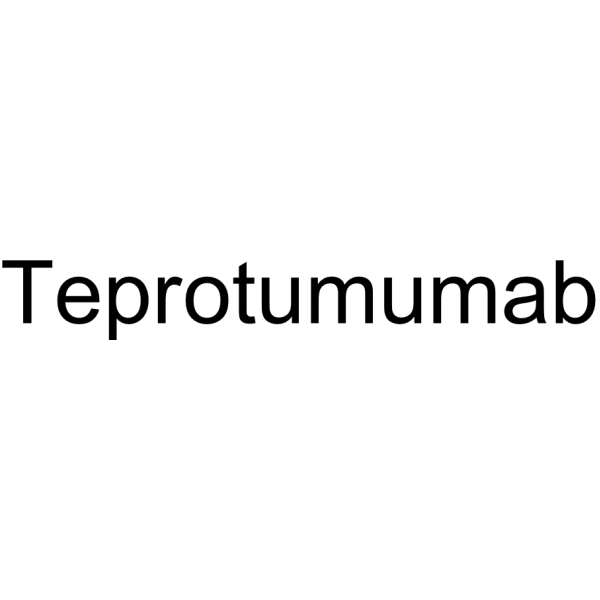
- HY-141551
-
|
|
Estrogen Receptor/ERR
|
Cancer
|
|
GNE-274 is a non-degrader that is structurally related to GDC-0927 (ER degrader). GNE-274 does not induce ER turnover and functions as a partial ER agonist in breast cancer cell lines. GNE-274 increase chromatin accessibility at ER-DNA binding sites, while GDC-0927 do not. GNE-274 is a potent inhibitor of ER-ligand binding domain (LBD). GNE-274 can be used for cancer research .
|
-
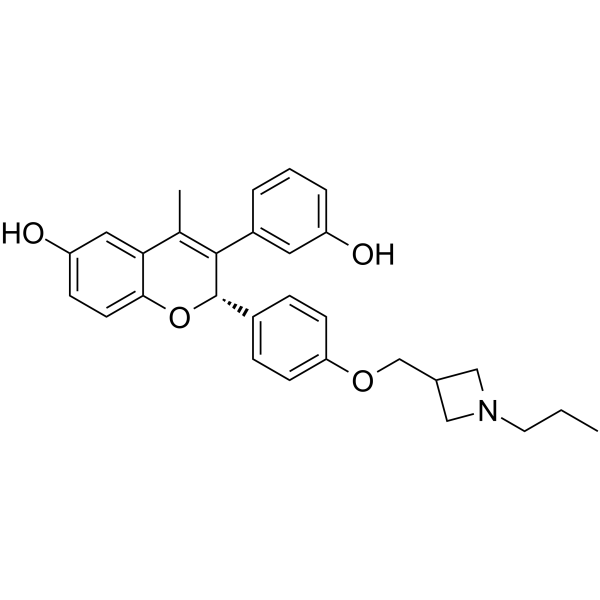
-
-
HY-L152
-
|
|
4973 compounds
|
|
19F-NMR has proved to be a detection mode in fragment-based drug discovery (FBDD) for studies of protein structure and interactions. 19F shows high sensitivity for NMR detection, and the exquisite sensitivity of 19F chemical shifts and linewidths to ligand binding all make it a valuable approach in FBDD.F (Fluorine) -Fragments can be used for 19F-NMR detection after binding to target proteins, and can be used as an effective 19F-NMR tool for FBDD.
MCE designs a unique collection of 4973 F-fragments, all of which obey a heuristic rule called the “Rule of Three (RO3)”, in which molecular weight ≤300 Da, the number of hydrogen bond donors (H-donors) ≤3, the number of hydrogen bond acceptors (H-acceptors) is ≤3 and cLogP is ≤3. This F-fragments library is an important source of lead-like drugs.
|
| Cat. No. |
Product Name |
Target |
Research Area |
-
- HY-P2264
-
|
|
Ephrin Receptor
|
Inflammation/Immunology
|
|
KYL peptide, an antagonistic peptide, selectively targets EphA4 receptor (IC50:4.22 μM, Kd:1.3 μM). KYL peptide binds to the ligand-binding domain of EphA4, effectively alleviates Aβ-induced synaptic dysfunction and synaptic plasticity defects in AD mice. KYL peptide can promote nerve regeneration after injury and modulating immune responses .
|
-
- HY-119782
-
|
|
Fluorescent Dye
|
Others
|
|
L-Argininamide is a hydrophilic amino acid derivative and can be used as a compound for ligand binding DNA aptamers. L-Argininamide has the potential for fluorescent aptasensors development .
|
| Cat. No. |
Product Name |
Target |
Research Area |
-
- HY-108822
-
|
Arcalyst; IL 1 Trap; Interleukin 1 Trap
|
Interleukin Related
|
Inflammation/Immunology
|
|
Rilonacept (Arcalyst), a dimeric fusion protein, is a interleukin 1 inhibitor. Rilonacept consists of the ligand-binding domains of the extracellular portions of the IL-1R components linked to the Fc portion of human IgG1. Rilonacept can be used for the research of cryopyrin-associated periodic syndromes .
|
-
- HY-P99446
-
|
TACI-Ig; TACI-Fc 5
|
Inhibitory Antibodies
|
Inflammation/Immunology
|
|
Atacicept (TACI-Ig) is a is a recombinant fusion protein containing the extracellular, ligand-binding portion of the TACI receptor and the Fc portion of human IgG. Atacicept inhibits B cell stimulation by binding to B lymphocyte stimulator and a proliferation-inducing ligand. Atacicept can be used in research of B-cell autoimmune disease .
|
-
- HY-P9977
-
|
JNJ-61186372
|
EGFR
|
Cancer
|
|
Amivantamab (JNJ-61186372) is a human EGFR-MET bispecific antibody with immune anticancer activity. Amivantamab inhibits ligand binding, promotes endocytosis and degradation of receptor-antibody complexes, and induces Fc-dependent cytokinesis in macrophages and antibody-dependent cytotoxicity in natural killer cells .
|
-
- HY-P99055
-
|
|
Inhibitory Antibodies
|
Inflammation/Immunology
Cancer
|
|
Urelumab, a fully human, non-ligand binding, CD137 agonist IgG4 monoclonal antibody, enhances T-cell and natural killer-cell antitumor activity, and may enhance cytotoxic activity of Rituximab (HY-P9913). Urelumab can be used for the research of diffuse large B-cell lymphoma (DLBCL), follicular lymphoma (FL), and other types of non-Hodgkin lymphoma (NHL) .
|
-
- HY-P99165
-
|
|
IGF-1R
TSH Receptor
|
Endocrinology
|
|
Teprotumumab is an IGF-1 receptor (IGF-1R) blocking human monoclonal antibody. Teprotumumab binds to the ligand binding extracellular α-subunit domain of IGF-1R. Teprotumumab inhibits TSH and IGF-1 action in fibrocytes. Teprotumumab attenuates TSH-dependent IL-6 and IL-8 expression and Akt phosphorylation. Teprotumumab can be used for thyroid-associated ophthalmopathy research .
|
| Cat. No. |
Product Name |
Category |
Target |
Chemical Structure |
| Cat. No. |
Product Name |
Chemical Structure |
-
- HY-13956S
-
|
|
|
Pioglitazone-d4 is a deuterium labeled Pioglitazone. Pioglitazone (U 72107) is a potent and selective PPARγ agonist with high affinity binding to the PPARγ ligand-binding domain with EC50 of 0.93 and 0.99 μM for human and mouse PPARγ, respectively[1].
|
-

-
- HY-B1322AS
-
|
|
|
Amodiaquine-d10 is the deuterium labeled Amodiaquine. Amodiaquine (Amodiaquin), a 4-aminoquinoline class of antimalarial agent, is a potent and orally active histamine N-methyltransferase inhibitor. Amodiaquine is also a Nurr1 agonist and specifically binds to Nurr1-LBD (ligand binding domain) with an EC50 of ~20 μM. Anti-inflammatory effect[1][2][3][4].
|
-

-
- HY-13956S1
-
|
|
|
Pioglitazone-d4 (alkyl) (U 72107-d4 (alkyl)) is the deuterium labeled Pioglitazone. Pioglitazone (U 72107) is a potent and selective PPARγ agonist with high affinity binding to the PPARγ ligand-binding domain with EC50 of 0.93 and 0.99 μM for human and mouse PPARγ, respectively[1][2].
|
-

-
- HY-117727S
-
|
|
|
Leriglitazone-d4 (MIN-102-d4; Hydroxypioglitazone-d4) is deuterium labeled Leriglitazone. Leriglitazone (Hydroxypioglitazone), a metabolite of pioglitazone.Leriglitazone (Hydroxypioglitazone) PioOH is a PPARγ agonist, stabilizes the PPARγ activation function-2 (AF-2) co-activator binding surface and enhances co-activator binding, affording slightly better transcriptional efficacy.Leriglitazone (Hydroxypioglitazone) binds to the PPARγ C-terminal ligand-binding domain (LBD) with Ki of 1.2 μM,induces transcriptional efficacy of the PPARγ (LBD) with EC50 of 680 nM .
|
-

-
- HY-B1322AS1
-
|
|
|
Amodiaquine-d10 hydrochloride is deuterated labeled Amodiaquine (HY-B1322A). Amodiaquine (Amodiaquin), a 4-aminoquinoline class of antimalarial agent, is a potent and orally active histamine N-methyltransferase inhibitor. Amodiaquine is also a Nurr1 agonist and specifically binds to Nurr1-LBD (ligand binding domain) with an EC50 of ~20 μM. Anti-inflammatory effect .
|
-

| Cat. No. |
Product Name |
Application |
Reactivity |
-
- HY-P82565
-
|
SORL1; C11orf32; Sortilin-related receptor; Low-density lipoprotein receptor relative with 11 ligand-binding repeats; LDLR relative with 11 ligand-binding repeats; LR11; SorLA-1; Sorting protein-related receptor containing LDLR class A repe
|
WB, IHC-P
|
Human, Mouse, Rat |
Your information is safe with us. * Required Fields.
Inquiry Information
- Product Name:
- Cat. No.:
- Quantity:
- MCE Japan Authorized Agent:



























































